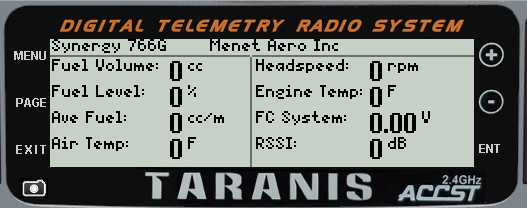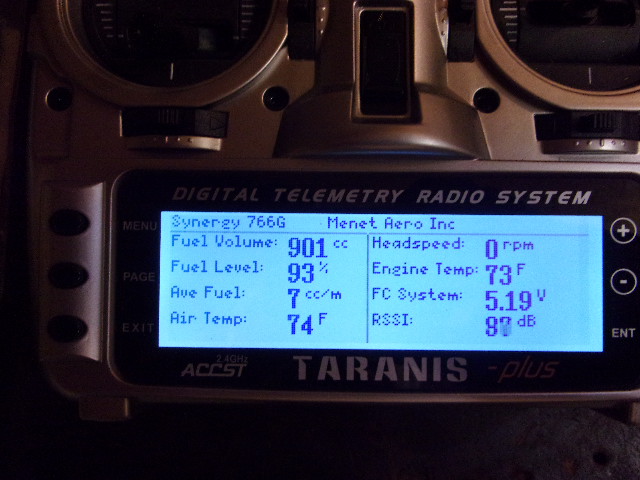Alex, in the FrSky Gas Suite the sensors are:
0D10 23 (Tmp1)
0D20 23 (rpm)
0D30 23 (Fuel volume remaining in cc)
0D40 23 (fuel percent left)
0D50 23 (current fuel flow)
0D60 23 max fuel flow)
0D70 23 (ave fuel flow)
0D00 23 (Tmp2)
So I don’t need to know max fuel flow or even current flow. I’m interested in average fuel flow and how much I got left. So I made my screen like this and I made the numbers big enough to be easily readable (otherwise it’s reading glasses in my old age here).

When you put gas in the helicopter tanks you go to the Gas Suite lua script and enter in the amount you put in the tanks. The heli holds 2.4L but I don’t always fly with that much. This is stored in the flash in the Gas Suite unit. So I can fly a flight and if I put in 1500cc and burned off 500cc, the next time I fire up the helicopter it shows that I got 1000cc of fuel left in the tanks. It also keeps track of average and max fuel flow and retains that start to start until I reset it with the Gas Suite script.
It’s pretty accurate but you have to calibrate the fuel flow sensor - that is done in the Gas Suite lua script too.
This is what mine looks like on the radio screen with actual values. I had put fuel in one tank and was running the helicopter on the ground at flight idle to do some tests on the generator/charging system. So it has 901cc of fuel left in it and average fuel burn on the ground running at flight idle with the clutch engaged was 7cc/min

If I don’t put more fuel in the next time I fly it, since it easily has 40-45 minutes of fuel in it, I’ll likely go into the Gas Suite script and reset the average fuel flow to zero so I can track average fuel consumption during the flight.
I don’t track the real-time fuel flow because it doesn’t tell you anything except that the engine is running and it’s burning fuel. The average tells you how much flight time you got left by dividing it into the remaining cc in the tanks.
I also got a girl in there that warns when there’s 10% fuel left. That is a one-time warning. And then she warns again when it’s down to less than 100cc (5 minutes left at usual average fuel burn). And she keeps complaining about low fuel every minute when it gets down to less than 100cc left in the tanks.
The voltage and RSSI comes from the receiver and that is the Flight Control System voltage that the Pixhack V5 is running on from its power module. The charging system voltage is higher (usually 7.9-8.0V depending on electrical load in the heli) and that’s shown on the Ground Station, also from the flight controller’s power module.
The battery stuff in the electric scripts doesn’t tell us anything for a helicopter that flies 2 hours in a flight and has a charging system. All it’s good for is similar to the battery meter or light in your car to tell that the alternator is working, or not. Although other gasser pilots that don’t have a charging system will probably want to know what the voltage is - but the amp draw on the flight systems battery can’t even be measured by any normal power module. So battery percentage, amps - means nothing because amps is always zero.